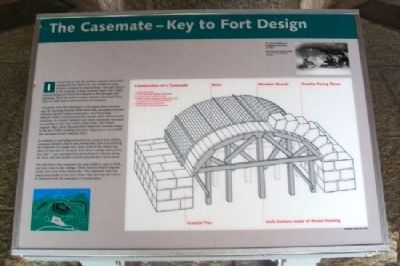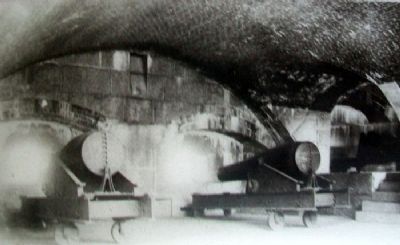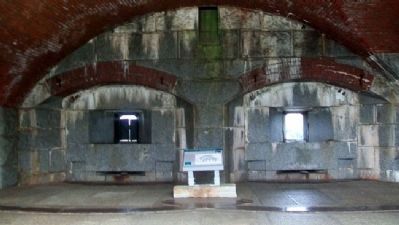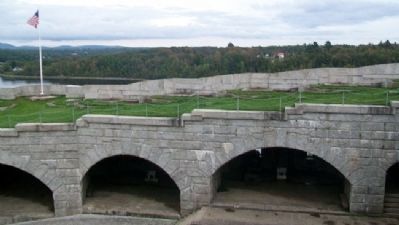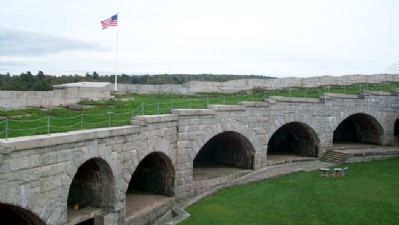Prospect in Waldo County, Maine — The American Northeast (New England)
The Casemate - Key to Fort Design
Inscription.
If you were to visit the nation's masonry forts built during the Fort Knox era, you would see many features common to most of them. One such feature is the casemate, a large enclosed space with a high, arched ceiling and places for cannons to fire through wall openings. All of the nation's major masonry forts built from 1816 to 1867 had at least one level of casemates.
Casemates were first developed in European forts centuries ago. By enclosing cannons within thick walls, casemates protected cannons and the soldiers firing them. But firing large cannons within confined spaces also created safety and structural problems. As a result, cannons were more commonly mounted on rooftops to fire over a fort's outer walls. The French engineer Marc Rene Montalembert improved casemate design in the late 1700s, enabling American engineers to successfully use casemates in new masonry forts.
In addition to providing protection for cannons and soldiers, casemates allowed a fort to have several tiers, thus concentrating the firepower of a single fort. Some forts of the period had three or four tiers of cannons. Fort Knox's design allowed for two tiers - one casemated tier protected 23 cannons along the front wall and smaller cannons planned for a level above.
You will notice that casemates are quite shallow, open in back, and have vents in the ceilings. These features helped disperse smoke and noise from cannon fire. The casemates were not joined structurally to the fort's front wall, allowing the wall to be destroyed and the casemates to remain intact.
Construction of a Casemate
1. Granite piers built
2. Wood frame arch centers constructed
3. Wooden boards nailed to frame
4. Layers of brick and granite facing stone laid on boards and mortared from behind
5. Additional layers of brick laid
6. Arch centers and boards removed
Erected by Maine Department of Conservation.
Topics. This historical marker is listed in these topic lists: Architecture • Forts and Castles. A significant historical year for this entry is 1816.
Location. 44° 33.962′ N, 68° 48.132′ W. Marker is in Prospect, Maine, in Waldo County. Marker is within a casemate inside the fort, at Fort Knox State Historic Site. Touch for map. Marker is at or near this postal address: 711 Fort Knox Road (Maine Route 174), Stockton Springs ME 04981, United States of America. Touch for directions.
Other nearby markers. At least 8 other markers are within walking distance of this marker. Where Did the Soldiers Sleep? (a few steps from this marker); The Heart of the Fort (a few steps from this marker); Digging Down and Building Up (a few steps from this marker); Firing a Cannon (a few steps from this marker); Fort Knox (within shouting distance of this marker); Terreplein (within shouting distance of this marker); A Grand Plan (within shouting distance of this marker); A Question of Boundaries (within shouting distance of this marker). Touch for a list and map of all markers in Prospect.
Also see . . . Fort Knox State Historic Site, Maine. (Submitted on May 13, 2012, by William Fischer, Jr. of Scranton, Pennsylvania.)
Credits. This page was last revised on September 24, 2020. It was originally submitted on May 11, 2012, by William Fischer, Jr. of Scranton, Pennsylvania. This page has been viewed 632 times since then and 15 times this year. Photos: 1, 2, 3, 4, 5, 6. submitted on May 13, 2012, by William Fischer, Jr. of Scranton, Pennsylvania.
